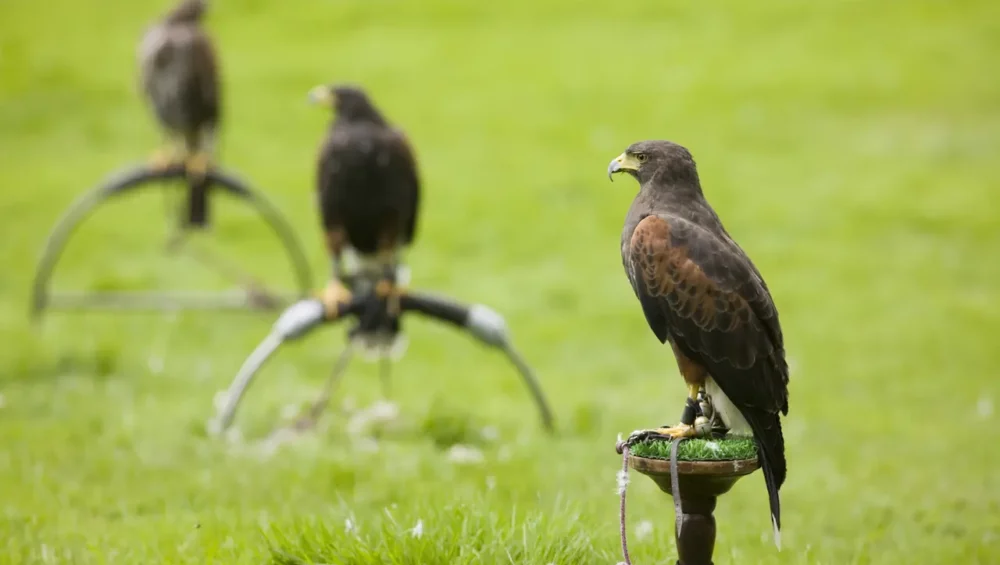Falconry, a captivating blend of sport, tradition, and nature, draws many enthusiasts to the world of birds of prey. But what exactly is falconry, and how are these majestic creatures trained to hunt and soar at the command of their human partners?
Understanding Falconry: A Brief History
Falconry has ancient roots, dating back thousands of years. Historically, it served as a vital method of hunting for food. Over time, it evolved into a respected sport and cultural tradition. From the Hittites’ stelae to medieval European nobility, falconry has captivated societies across the globe.
The journey of falconry through history also saw it as a status symbol for the nobility. Owning and flying these magnificent birds marked a sign of prestige and power. It was during the Middle Ages in Europe that falconry reached its zenith, becoming deeply intertwined with the aristocratic way of life.
Despite facing decline due to modern hunting techniques, falconry experienced a revival in the 1970s. This resurgence was fueled by conservation efforts and renewed interest in the traditional sport, marking a new era of appreciation for the skill and dedication involved in falconry.
Types of Birds of Prey Used in Falconry
Falconers often train species such as falcons, hawks, and eagles, each chosen for their unique hunting skills and adaptability to human training. Longwinged falcons like peregrines and saker falcons are renowned for their speed and agility in the air.
Shortwinged hawks, such as the goshawk and the sparrowhawk, are adept at navigating denser terrains and are known for their rapid, powerful pursuits. These versatile hunters can flush out ground game and birds hiding in thick cover.
Additionally, eagles and other broadwinged raptors bring strength and size to the table, often used in more open landscapes. They exemplify power and precision when hunting larger prey, showcasing their dominance in the sky.
The Basics of Training Birds of Prey
Successful training hinges on understanding a bird’s natural instincts. Patience, consistency, and positive reinforcement are critical in teaching birds to respond to commands. A fundamental step is called “manning,” where the bird becomes accustomed to the falconer.
Establishing a routine is essential, involving regular interactions and careful observation of the bird’s behavior and temperament. During this period, the bird learns to associate the falconer with food and safety, laying the foundation for more advanced training steps.
Gradually, the bird is introduced to basic commands, starting with short flights to the falconer’s glove. This trust-building stage is crucial for future training, ensuring the bird feels comfortable and confident in its movements.
Building Trust: The First Step to Training
Establishing trust is fundamental. This initial phase includes familiarization with the falconer and surroundings, helping the bird feel secure and ready to learn. This often involves hand-feeding to initiate bonding and increase the bird’s comfort with human presence.
Both falconer and bird engage in non-threatening activities to nurture the bond gradually. Activities are often informal and gentle, focusing on allowing the bird to fly short distances freely or sit calmly on the falconer’s glove.
Advanced Training Techniques and Tools
Advanced methods like lure flying and creance training enhance a bird’s hunting skills. Tools such as gloves, hoods, and jesses are essential for safe handling. Lure flying, for example, mimics prey to develop the bird’s pursuit instincts safely and effectively.
In time, a creance, or long line, is used to allow the bird to experience freedom while still ensuring safety. This is when the bird’s speed and precision are honed for field performance, adjusting weight and food intake to maintain peak condition.
Each tool and technique has a specific role in refining the bird’s capabilities, entrusting the falconer to manage every detail meticulously. This precision, akin to a relationship with a trusted partner, underpins the art of falconry.
The Role of Diet and Health in Falconry
A balanced diet and regular health checks are vital. Understanding the nutritional and health needs of birds ensures their well-being and optimal performance. A falconer’s care regime is tailored to each bird’s specific dietary requirements, accommodating their unique feeding habits.
Health checkups are also crucial, as they detect early signs of illness that might affect a bird’s ability to perform. Practicing regular inspections ensures birds remain robust and energetic for their training sessions.
By monitoring health and nutrition, falconers establish a robust foundation on which the bird’s training and development can rely. This holistic approach encapsulates the pride and responsibility inherent in falconry.
The Art and Partnership of Falconry
Falconry is more than just a sport; it is a profound partnership between humans and birds of prey. Through understanding their behaviors, building trust, and employing meticulous training methods, falconers and their avian companions create a harmonious bond that celebrates the ancient art of hunting with these majestic birds. Engage with nature and experience the thrill by visiting Greenbrier Outfitters, where you can partake in our unique falconry excursions.


